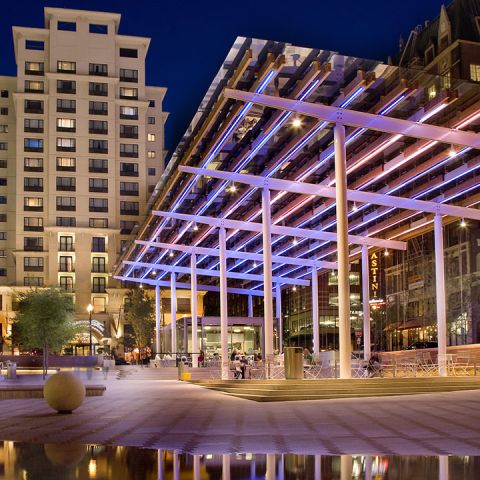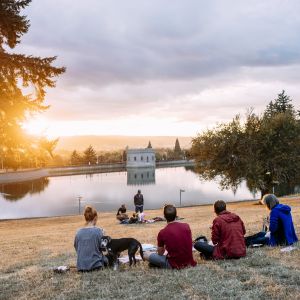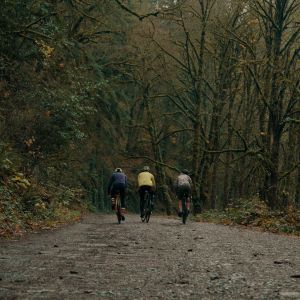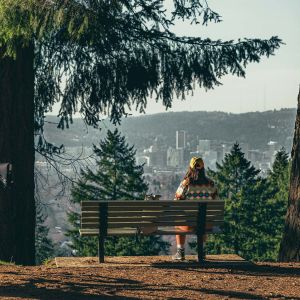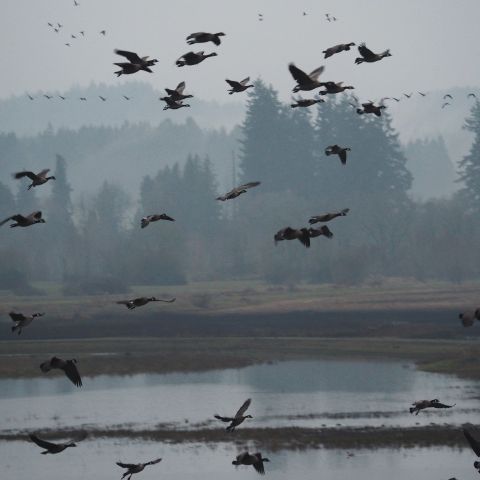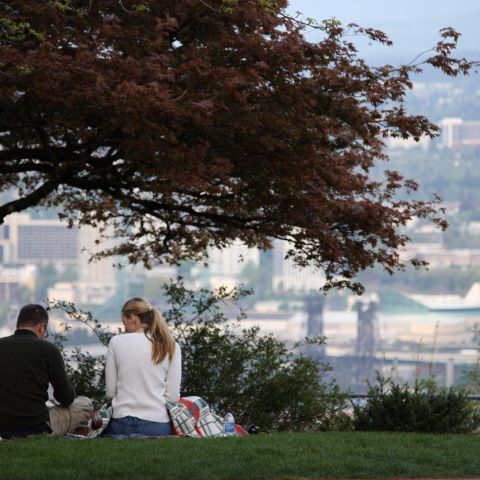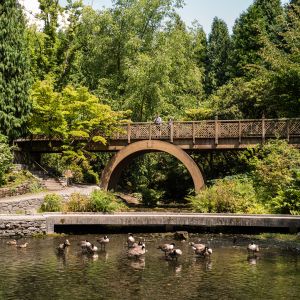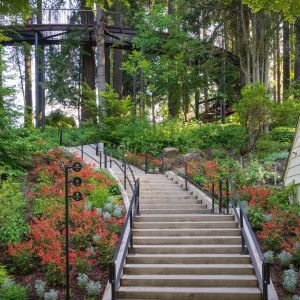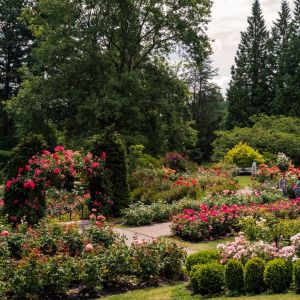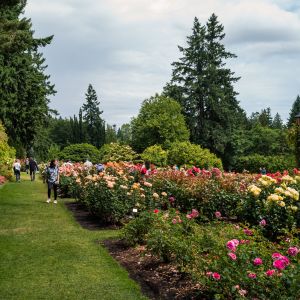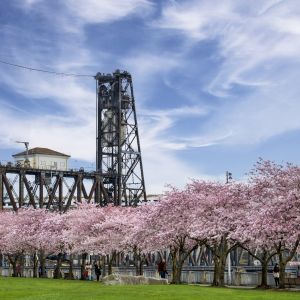Parks & Gardens
Portland’s green spaces range from flower-filled parks to polished gardens, urban forests to waterfront venues.
In a city as green as Portland, it’s only fitting that some of the top things to do are outdoor spots that appeal to home gardeners and hikers alike.
There are more than 200 parks and gardens within city limits, from forests to marshlands, trails to skateboarding rails. Home to the sprawling urban wilderness of Forest Park along with the world’s smallest dedicated park, Mill Ends Park, Portland offers visitors a breath of fresh air wherever they are.
Find Portland Parks
Downtown
Director Park
This former parking lot in the Downtown neighborhood was converted into a public square in 2009. Located just a block from Pioneer Courthouse Square, Director Park features a café, ample outdoor seating and a fountain with gentle jets and bubbles that fill a shallow basin ringed by low wooden benches and plays host to occasional events in the summer.
Keller Fountain Park
The Keller Fountain is cut into the block facing the Keller Auditorium and evokes the cliffs and waterfalls of the nearby Columbia River Gorge. Splash in the pool at the bottom, wade in the shallow basins atop the “waterfalls” or just enjoy the sound of the rushing water in the midst of downtown.
Lovejoy Fountain Park
Hidden away just five blocks from the Keller Fountain is another fountain designed by Lawrence Halprin’s acclaimed firm (just like the Keller Fountain). The Lovejoy Fountain takes its inspiration from mountain lakes and streams.
Mill Ends Park
At 24 inches (61 centimeters) in diameter, Mill Ends Park is the world’s smallest dedicated park. Located in the median of Southwest Naito Parkway at Taylor Street, its story began when a journalist for the Oregon Journal, Dick Fagan, got tired of looking at the ugly pothole below his office window. He decided to plant flowers in the hole and name it Mill Ends Park. To generate interest in this tiny green space, Fagan centered many newspaper stories around the capers of a fictitious park resident, a leprechaun named Patrick O’Toole.




Pioneer Courthouse Square
Located in the heart of downtown Portland Pioneer Courthouse Square is affectionately known as the city’s “living room.” Once a grim parking structure, the square is now a thriving urban park and the single most-visited site in Oregon, attracting more than 9.5 million visitors annually. The square’s on-site resources include TriMet’s bus and light rail ticket office. The square is also one of Portland’s leading outdoor venues, hosting 300 events each year, from large-scale concerts to cultural festivals.
Waterfront Park
Once the site of a freeway, Tom McCall Waterfront Park is a downtown riverfront park popular for jogging, in-line skating and cooling off several fountains placed along the park, like Salmon Street Springs, a fountain whose water patterns change with the city’s mood.
The park bears the name of former Oregon Governor Tom McCall, a staunch advocate of recycling, environmental preservation and urban planning. This 1.5-mile (2.4 km) stretch of green along the Willamette River is home to many annual events, including the Portland Rose Festival, and the Waterfront Blues Festival.
The Bill National Legacy Fountain at the end of the plaza built for the Portland Saturday Market incorporates two distinct play areas: a blowhole-dotted section that operates when no events are taking place on the plaza and an adjacent amphitheater that runs more frequently. The blowholes are perfect for toddlers and older kids, and the amphitheater involves a compelling sequence of water arches. A few steps beyond the fountain, every spring, you’ll find the cherry blossoms bursting near the Japanese American Historical Plaza, located at the north end of the park.
Splash Pads in Portland Parks
Know Before You Go
Note: All city fountains and splash pads are turned on by Memorial Day weekend and operate through September.
Many local parks also feature “splash pads,” which provide the quintessential summertime experience of running through a sprinkler — but without the sprinkler! Nozzles built into the ground spray clean water upwards, which then drains back into the ground (meaning there’s no risk of accumulating water for little ones to get caught in). Check out the full list here.
Downtown Parks
From the smallest park to a path along the river, these parks downtown are a sight to see.
Director Park
Downtown Portland’s Director Park is a European-style, granite-paved plaza with outdoor seating and a fountain; a perfect respite from the bustle of the city.
Mill Ends Park
Located in downtown Portland, the world’s smallest park is kind of a big deal. The stories of how Mill Ends Park came to be hold a big surprise for 452 square inches.
Governor Tom McCall Waterfront Park
Hugging the Willamette River in downtown Portland, this once bustling highway now offers a strollable, bikeable and dog-walkable public park with historical and cultural monuments, and kid-friendly fun.
Pearl District
Jamison Square
On summer days, Jamison Square becomes a no-holds-barred kids’ park featuring a gentle fountain and generous space for wading. Adults will appreciate the convenience of the Pearl District park’s location on the Portland Streetcar line and the impressive public art — modern “totem poles” designed by Kenny Scharf.
Tanner Springs Park
Tanner Springs Park is a living example of Portland’s eco-consciousness: a thriving wetland in the heart of the urban Pearl District neighborhood.



West Hills
Forest Park
Located northwest of downtown, this 8-mile-long (13 km) “forest in the city” covers 5,156 acres (2,086 ha). In addition to providing a respite from urban life, Forest Park supports more than 112 birds and 62 mammal species and acts as a natural air purifier. Forest Park’s 70 miles (113 km) of trails are popular with runners, equestrians, hikers and cyclists alike. Dogs on leashes are allowed. The 30-mile (48 km) Wildwood Trail connects Forest Park, Pittock Mansion and Washington Park.
Within Forest Park, the 4.5 miles (7.24 km) of maintained trails at the Bird Alliance of Oregon is a 143-acre (58 ha) wildlife nature sanctuary that takes visitors through a mixed coniferous forest, streams, ponds, and native vegetation, all within minutes of downtown Portland. The Bird Alliance (formerly Portland Audubon) features an interpretive center, a nature store with products for wildlife and nature viewing, as well as products from local artists.
Parks With Trails
Portland parks are filled with outdoor activities and adventure.
Tryon Creek State Park
Located 15 minutes south of downtown, Tryon Creek Park and Natural Area is Portland’s only state park and features miles of trails under a mixed forest canopy. The 645-acre (261 ha) park’s namesake Tryon Creek is home to a run of steelhead trout. In addition to 3.5 miles (5.6 km) of horse trails and a 3-mile (5 km) paved bicycle path, the park has 8 miles of hiking trails, including the .35-mile (.6 km), fully accessible Trillium Trail, with paved pathways, drinking fountains, resting benches and viewing decks. The Nature Center provides interpretive displays and restrooms. Dogs are allowed on leashes.
Washington Park
Located atop the hills west of downtown, 410-acre (166 ha) Washington Park offers up a zoo, two museums, a spectacular rose garden, one of the most authentic Japanese gardens in the world and more, all bordered by Forest Park –its grounds include 5,100 acres (2,064 ha), one of the country’s premier urban wildernesses. Washington Park is one of the oldest, best-loved and most well-used parks in Portland.
Hoyt Arboretum
Nearly 2,000 species of trees and shrubs are showcased on 185 acres (75 ha) of hilly terrain within Washington Park. An interpretive center offers restrooms, maps and brochures and a gift shop. The 21 trails of Hoyt Arboretum cover 12 miles (19 km); two miles of trail are suitable for wheelchairs, baby strollers and visitors who appreciate firm footing. See a map of the trails.
Park Activities
Portland makes it easy to spend an entire day outside.
Bird-Watching in Portland
Catch sight of 200+ types of birds at the Portland area’s dozens of prime bird watching destinations, including sanctuaries, refuges and urban parks.
Portland Picnic Guide
Nothing beats spreading out a picnic blanket on a sunny day, and Portland has no shortage of delicious grab-and-go eats and scenic spots for a feast.
Kickstand Comedy Brings Laughs to Portland’s Laurelhurst Park
Friday evenings in the summer grab a picnic and head to Portland’s Laurelhurst Park for Kickstand Comedy in the Park, a series of free outdoor shows featuring local and national standup comics.
Eastside
The Grotto
A peaceful oasis in the midst of the city, The Grotto is set among 62 acres (25 ha) of botanical gardens. As an internationally renowned Catholic sanctuary, The Grotto offers a place of quiet reflection for all people. More than 100 beautiful statues and shrines are nestled among flower-lined pathways winding under towering firs. Peaceful ponds, spectacular cliffside vistas and award-winning architecture offer inspiration for all who visit this natural gallery in the woods. Gardens and gift shop are open daily; group tours and daily Mass are also offered.
Open year-round; hours vary. There is no charge to see the lower-level gardens and structures. To access the upper gardens, each visitor must purchase an elevator token.






Laurelhurst Park
Just north of Portland’s Belmont neighborhood sits Laurelhurst Park, one of the city’s most scenic escapes. This 31-acre (12.5 ha) park really does have something for everybody to enjoy. The central lawn is the perfect spot for an afternoon picnic, there is a duck pond, and the park hosts an array of free public events.
Leach Botanical Gardens
The nine-acre (3.6 ha) Leach Botanical Gardens boasts more than 2,000 species, hybrids and cultivars, including Northwest native plants, as well as viburnums, camellias and azaleas of the southeastern United States.
The garden has an interpretive center, restrooms, trails and wildlife viewing areas. Limited wheelchair accessibility; pets not allowed; closed Mondays and some holidays.
Gardens Galore
Dig into these perfectly planted gardens across the Rose City.
Mt. Tabor Park
Mount Tabor makes Portland one of only three cities in the continental United States to contain an extinct volcano within its boundaries (the others are Bend, Ore., and Jackson, Miss.). Established in 1909 Mt. Tabor Park was named to the National Register of Historic Places in 2004. Three municipal reservoirs are at the heart of the 196-acre (79 ha)) park, which also features trails popular with both bicyclists and pedestrians. The cinder cone’s 630-foot (192 m) elevation affords views of downtown Portland and Mount Hood.
Oaks Bottom Wildlife Refuge
The 140-acre (56.7-hectare) Oaks Bottom Wildlife Refuge is a wetland just east of the Willamette River in Sellwood and a birdwatchers’ paradise. Many species are attracted to the marshes of Portland’s first wildlife refuge, including the city’s official bird, the great blue heron.
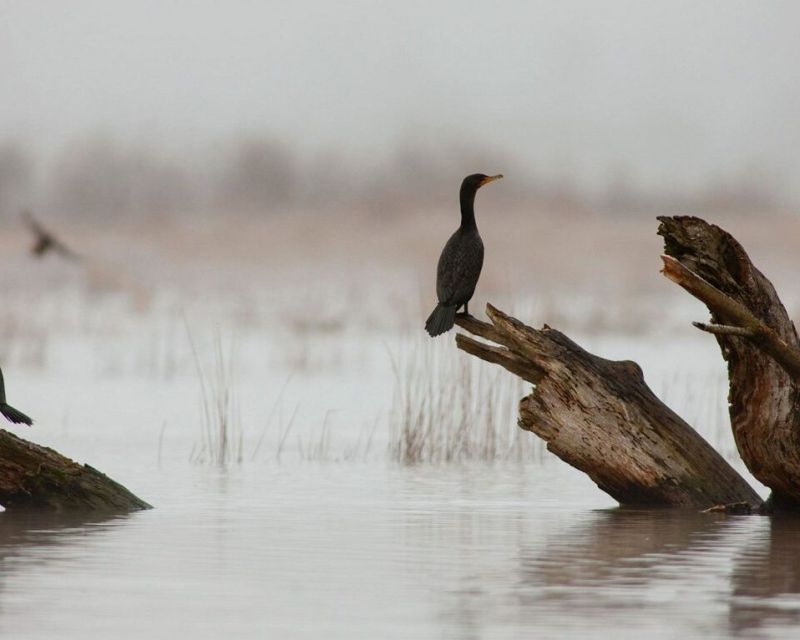





Wildlife Preserves Near Portland
At the northernmost point of Portland, along the Columbia River, you’ll find the largest protected wetlands within a U.S. city; Smith and Bybee Wetlands Natural Area. With a 205-acre (83 ha) waterway and haven for many animal species and heaven for nature-seeking hikers, bikers, and kayakers. Composed of two lakes (the Smith and the Bybee), this public parkland is home to beavers, black-tailed deer and even bald eagles, which can be seen from two wildlife-viewing platforms.
This 650-acre (263 ha) wildlife preserve west of Portland in Hillsboro, Ore., features expansive wetlands and an abundance of wildlife viewing opportunities. Jackson Bottom Wetland Preserve amenities include a community center with interpretive displays and restrooms, a wheelchair-accessible wildlife-viewing platform and additional trails. Free and open from dawn to dusk.
On the outskirts of Portland in the Columbia River, Sauvie Island is a rural oasis, where visitors can pick seasonal fruits and vegetables or sample local treats from field stands and farmers’ markets. Parks, beaches and wetlands attract wildlife and nature lovers alike. Fall brings bright colors, pumpkin patches — even a corn maze to weave through.
Tualatin River Nation Wildlife Refuge is a place to discover an ever-changing panorama of wildlife. As the seasons change, so do the wildlife viewing opportunities. Located on the Pacific Flyway, the Refuge is an important stopover where migrating waterfowl, songbirds, and shorebirds stop to rest, refuel, and raise their young.
Was this page helpful?
